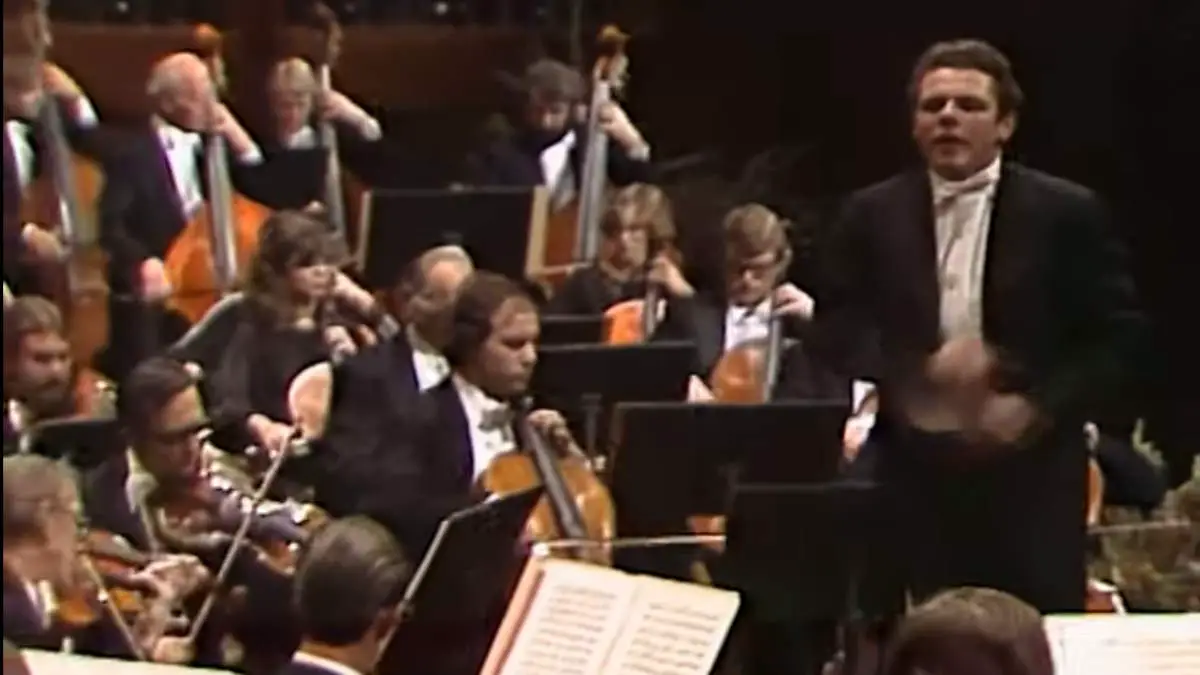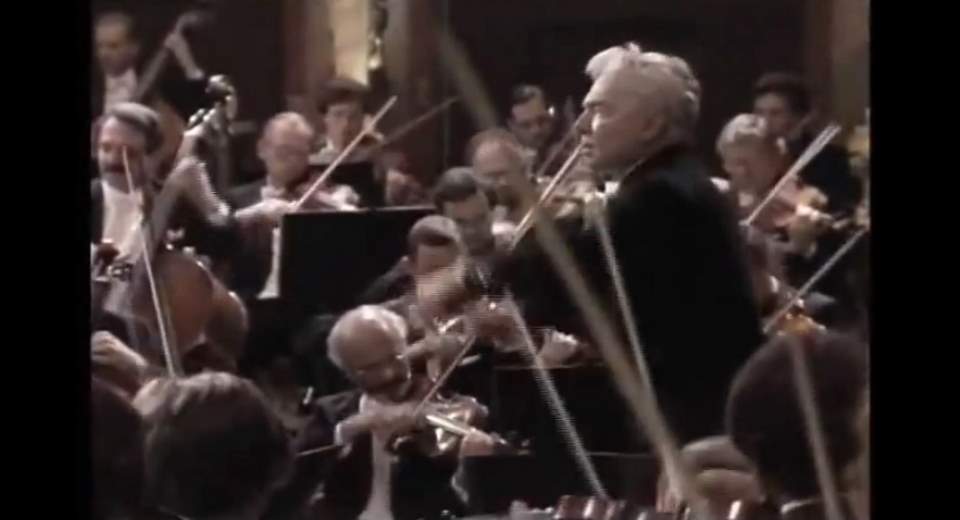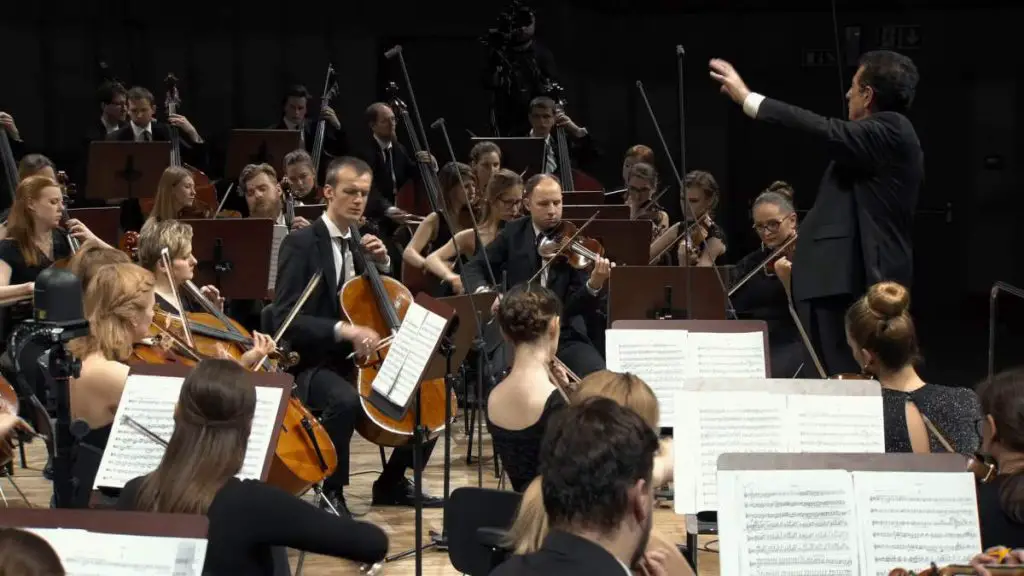Conducted by Mariss Jansons, the Oslo Philharmonic Orchestra performs Pyotr Ilyich Tchaikovsky’s Symphony No. 4 in F minor, Op. 36. This iconic performance was recorded at the Oslo Concert Hall on September 27, 1979.
Tchaikovsky’s Symphony No. 4
Tchaikovsky’s Symphony No. 4 in F minor, Op. 36, is a monumental work that marks a significant turning point in the composer’s musical expression and personal life. Composed between 1877 and 1878, this symphony is often regarded as an intensely emotional reflection of Tchaikovsky’s tumultuous state during a critical period.
The genesis of Symphony No. 4 is closely tied to two major events in Tchaikovsky’s life: his disastrous marriage to Antonina Miliukova and his developing relationship with his benefactress, Nadezhda von Meck. The marriage, which lasted only a few weeks, left Tchaikovsky emotionally and physically distressed.
During this time, he began corresponding with von Meck, who became an important figure in his life, providing him both financial support and emotional sustenance. This relationship allowed Tchaikovsky the freedom to compose without financial worries, and their exchange of letters provided insight into his thoughts and feelings during the composition of the symphony.
In a letter to von Meck, Tchaikovsky explained that the symphony was imbued with a ‘program’ or underlying narrative, which he later preferred to keep private. He hinted, however, that the work reflected his feelings of melancholy and the inevitability of fate, a theme underscored by the symphony’s recurring “fate” motif, a powerful and foreboding fanfare that opens the first movement and reappears throughout the symphony.
Musically, Symphony No. 4 is notable for its bold and innovative orchestration, dramatic contrasts, and the integration of Russian folk melodies, which add a unique nationalistic flavor to the work. The symphony is structured traditionally but infused with a new level of emotional depth and structural coherence. Tchaikovsky’s use of the orchestra is masterful, crafting textures that range from the delicate and introspective to the grand and tumultuous.
The premiere of Symphony No. 4, conducted by Nikolai Rubinstein, was a success and marked a public and critical acknowledgment of Tchaikovsky’s talents. Over time, the symphony has grown in popularity, becoming one of the composer’s most famous and frequently performed works. It stands as a pivotal work in Tchaikovsky’s output, reflecting both his personal struggles and his maturation as a composer. The symphony remains a profound statement on the power of fate and the pursuit of personal expression within the framework of the classical symphonic tradition.
Movements
1. Andante sostenuto – Moderato con anima
The first movement of Tchaikovsky’s Symphony No. 4 in F minor, Op. 36, is marked “Andante sostenuto – Moderato con anima,” and it is a powerful and expansive piece, filled with dramatic intensity and emotional depth. This movement is particularly notable for its introduction of the “fate” motif, a striking and ominous fanfare that opens the symphony and becomes a recurring theme throughout the work.
The movement begins with brass and woodwinds declaring the fate motif, characterized by a loud, forceful, and somewhat menacing series of chords. This motif sets the tone for the entire symphony, symbolizing the force of fate that, according to Tchaikovsky’s own explanation in his letters, hangs over one’s head like the sword of Damocles. After the initial fanfare, the strings take over with a more lyrical yet anxious theme that continues to build the emotional landscape.
The development of the movement is complex, featuring a rich interplay of themes and a masterful orchestration that showcases Tchaikovsky’s ability to handle large forms and contrasting elements. As the movement unfolds, it moves through a series of emotional peaks and valleys, with the orchestra expanding the initial themes into more elaborate and expressive forms.
Tchaikovsky employs a traditional sonata form for this movement but infuses it with a deeply personal and almost narrative quality, reflecting his inner turmoil and struggles. The interplay between the menacing fate motif and the more lyrical, yet anxious, melodies creates a dialogue of inevitable doom versus personal emotion and struggle.
As the movement progresses towards the recapitulation, the fate motif reappears, this time even more forcefully, reaffirming its unrelenting presence and influence. The movement concludes with a powerful coda that revisits the opening fanfare, ending on a note that is both resolute and unsettling, leaving a lasting impact on the listener.
2. Andantino in modo di canzona
The second movement of Tchaikovsky’s Symphony No. 4, titled “Andantino in modo di canzona,” stands in stark contrast to the intense and turbulent first movement. This movement exudes a more lyrical, melancholic quality, showcasing Tchaikovsky’s profound ability to convey deep emotion through more subdued and tender musical expressions.
The movement opens with a plaintive oboe melody that sets a reflective and somewhat sorrowful tone. This theme is beautifully crafted, weaving a sense of longing and introspection that resonates deeply. The melody is then taken up by the string section, which elaborates and expands upon it, adding layers of emotional depth and complexity.
Throughout this movement, Tchaikovsky employs a simple yet highly effective orchestration, allowing the woodwinds to shine by interspersing delicate solos that converse with the strings. The orchestration is delicate and restrained, which contrasts with the dense textures and vigorous dynamics of the rest of the symphony. This creates an intimate atmosphere that draws listeners into a more personal and introspective space.
Structurally, the movement is relatively straightforward, adhering to a modified song form that enhances its lyrical and song-like character. This format allows the initial theme to return in various guises, each time slightly altered to reflect a deepening of the emotional landscape. The interplay between the different sections of the orchestra adds to the conversational and narrative feel of the movement.
The emotional climax of the movement comes as the initial theme is developed and intensified, expressing a poignant sense of yearning and melancholy. This is followed by a more subdued and reflective passage that gradually winds down, leading to a gentle and somewhat unresolved conclusion.
3. Scherzo: Pizzicato ostinato – Allegro
The third movement of Tchaikovsky’s Symphony No. 4, marked “Scherzo: Pizzicato Ostinato, Allegro,” provides a distinct shift in mood and texture from the preceding movements. This movement is notable for its unique orchestration and playful character, serving as a lighter, more whimsical contrast within the symphony.
The entire movement is characterized by the strings playing pizzicato throughout, creating a crisp, staccato texture that is both lively and delicate. The pizzicato technique, where strings are plucked rather than bowed, lends the movement an airy, almost ethereal quality. This choice of instrumentation creates a sparkling effect, evoking images of fine, intricate lacework.
Structurally, the scherzo adheres to the traditional ABA form, common in symphonic scherzos. The A section is buoyant and rhythmic, featuring a playful theme that is passed around various sections of the orchestra. This theme is light-hearted and almost dance-like, inviting a sense of mischievousness and joy. The orchestration remains light, with the plucking strings maintaining a continuous, driving rhythm that underpins the movement.
The B section, or trio, introduces a contrasting melody that is somewhat more lyrical and flowing, yet still played entirely pizzicato. This melody provides a brief respite from the rhythmic intensity of the A section, offering a softer, more melodic perspective.
As the movement progresses back to the A section, the playful theme returns, regaining its brisk, rhythmic pace. Tchaikovsky skillfully manipulates the dynamics and textures, creating shifts that enhance the movement’s playful and capricious nature. The movement builds towards a lively conclusion, reasserting the initial themes and culminating in a spirited and whimsical finale.
4. Finale: Allegro con fuoco
The fourth and final movement of Tchaikovsky’s Symphony No. 4, marked “Finale: Allegro con fuoco,” is a vibrant and exuberant conclusion to the symphony. This movement is characterized by its dynamic energy, rhythmic drive, and the triumphant return of the “fate” motif introduced in the first movement, bringing the symphony full circle in a dramatic and powerful way.
The movement bursts forth with a bold and spirited theme that is immediately engaging. This theme, based on a Russian folk song “In the Field Stood a Birch Tree,” infuses the movement with a distinctly nationalistic flavor, aligning with Tchaikovsky’s frequent incorporation of folk elements into his symphonic works. The theme is presented with full orchestral force, driving the movement forward with a sense of unstoppable momentum.
Tchaikovsky’s orchestration in this finale is robust and colorful, utilizing the full capabilities of the orchestra to create a rich tapestry of sound. The brass and woodwinds play a particularly prominent role, delivering the thematic material with clarity and power, while the strings provide a vigorous underpinning that propels the movement.
The structure of the movement is somewhat akin to a rondo, where the main theme returns several times, interspersed with contrasting episodes. These episodes explore different moods and motifs, including a lyrical, more subdued passage that offers a brief respite from the energetic main theme. However, the pace and intensity quickly ramp up each time the main theme returns, building towards a climactic finale.
As the movement approaches its conclusion, the “fate” motif from the first movement reappears, now transformed and integrated into the fabric of the finale. This reintroduction serves as a thematic bookend to the symphony, tying together the narrative thread of fate and struggle that has permeated the work. The integration of this motif adds a layer of depth and coherence to the symphony, reinforcing the underlying themes of destiny and resolution.
The finale culminates in a thrilling and triumphant coda, where the orchestra comes together in a full, resounding declaration. The energy is sustained to the very last note, ending the symphony on a powerful and emphatic note.
Sources
- Symphony No. 4 (Tchaikovsky) on Wikipedia
- Symphony No. 4 in F Minor, Op. 36 on the Encyclopedia Britannica website
- Symphony No. 4, Op. 36 (Tchaikovsky, Pyotr) on the International Music Score Library Project website
- Schubert: Winterreise [Peter Schreier, Sviatoslav Richter] - May 21, 2024
- Mozart: Violin Concerto No. 7 [Henryk Szeryng] - May 20, 2024
- Joaquín Rodrigo: Concierto de Aranjuez [Bokyung Byun] - May 18, 2024


